

I checked "Automatic" and then connected the iPad to my PC via USB. In the "Transfer to Mac or PC" option, you can choose "Automatic" or "Keep Originals" (according to iOS: "Automatic transfer photos and videos in a compatible format, or always transfer the original file without checking for compatibility). Now, having edited some photos and then saved them with the first option, I want to transfer those modified RAWs from the iPad to my Lightroom library on the Windows PC.īefore doing so, I've checked the Photos settings on iOS. Now, if you are familiar with Snapseed, you'll know that when it comes to saving/exporting your work, you have three options: "Save", which implies modifying the RAW itself with the possibility of coming back and editing the file again or undoing the changes (iOS wil ask for permission to modify the photo), "save a copy", which creates a copy of the RAW that will be editable too, and "export", which just creates a jpg copy with undoable changes. Then I used Snapseed to edit those files. I've transfered some RAWs from an SD card to my iPad using the Lightning adaptor. The volume rewinds in time to that point.I'm using an original iPad Air with iOS 12.4.5 and a PC with Windows 7 and Lightroom Classic CC 8.1.

For details on working with CCC’s use of APFS snapshots, read on.ĪPFS allows the creation of a snapshot as a sort of “fast rewind.” Instead of restoring everything on your volume, if you restore from an APFS snapshot, only the changes between the current state of your volume and the state of the snapshot need be applied.

Apple started rolling out APFS a few releases of macOS ago.

Time Machine: Time Machine writes temporary snapshots to the local volume in preparation of copying them to a local or network volume that’s not immediately available.You might encounter snapshots seemingly filling your startup volume from one of two pieces of software:


 0 kommentar(er)
0 kommentar(er)
